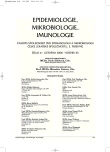Molecular Epidemiology of Invasive Meningococcal Disease in the Czech Republic
Molekulární epidemiologie invazivního meningokokového onemocnění v České republice
Cílem práce je prezentace výsledků klonální analýzy izolátů Neisseria meningitidis z invazivního meningokokového onemocnění v České republice z období 1993–2005. Metodou multilokusové sekvenční typizace (MLST) byla zjištěna genetická heterogenita izolátů séroskupiny B a homogenita izolátů séroskupiny C. U izolátů séroskupiny B prevalovaly tři sekvenční klonální komplexy (STC-18, STC-32 a STC-41/44) a téměř čtvrtina izolátů vykazuje ST nezařaditelné do klonálních komplexů. U izolátů séroskupiny C byla zjištěna výrazná prevalence STC-11. Hypervirulentní klonální komplex STC-11 prevaloval v letech 1993–2004, v roce 2005 byl poprvé zjištěn vyšší výskyt jiného klonálního komplexu: STC-41/44. MLST analýza ukázala odlišnost populace českých meningokoků od západoevropských a ostatních populací. Výsledky klonální analýzy izolátů Neisseria meningitidis z invazivního meningokokového onemocnění jsou podkladem k hodnocení správnosti doporučených opatření v ohnisku onemocnění a k aktualizaci doporučené vakcinační strategie v České republice.
Klíčová slova:
invazivní meningokokové onemocnění – Neisseria meningitidis – multilokusová sekvenční typizace, MLST – molekulární epidemiologie.
Authors:
P. Křížová
; J. Kalmusová; M. Musílek
Authors‘ workplace:
Národní referenční laboratoř pro meningokokové nákazy, Státní zdravotní ústav, Praha
Published in:
Epidemiol. Mikrobiol. Imunol. 55, 2006, č. 4, s. 140-150
Overview
The study objective is to present results of clonal analysis of Neisseria meningitidis isolates from invasive meningococcal disease in the Czech Republic in 1993–2005. The method of multilocus sequence typing (MLST) revealed genetic heterogeneity of serogroup B isolates and homogeneity of serogroup C isolates. Three clonal sequence type complexes (STC-18, STC-32 and STC-41/44) prevailed among serogroup B isolates and almost a quarter of isolates have ST unclassifiable into clonal complexes. STC-11showed clear predominance among serogroup C isolates. Hypervirulent clonal complex STC-11 prevailed in 1993–2004 while another clonal complex, STC-41/44, became more widespread for the first time in 2005. MLST analysis showed differences between the meningococcal population in the Czech Republic and those in western European countries and elsewhere. The results of clonal analysis of Neisseria meningitidis isolates from invasive meningococcal disease provide background information for evaluation of the adequacy of recommended measures in the focus of the disease and for updating the recommended vaccination strategy in the Czech Republic.
Key words:
invasive meningococcal disese – Neisseria meningitidis – MLST – molecular epidemiology.
Labels
Hygiene and epidemiology Medical virology Clinical microbiologyArticle was published in
Epidemiology, Microbiology, Immunology

2006 Issue 4
Most read in this issue
- Mumps – a Reemerging Infection? The Current Incidence of Mumps in the East Bohemian Region in the Czech Republic
- Microbiology Online – Interactive Learning and a New Discussion Forum for Microbiology Teachers
- Prevalence of Hepatitis G Virus (HGV) in Intravenous Immunoglobulin Recipients in the Czech Republic
- Nontuberculous Mycobacteria and Incidence of Mycobacterioses in Prague in 1999–2004
